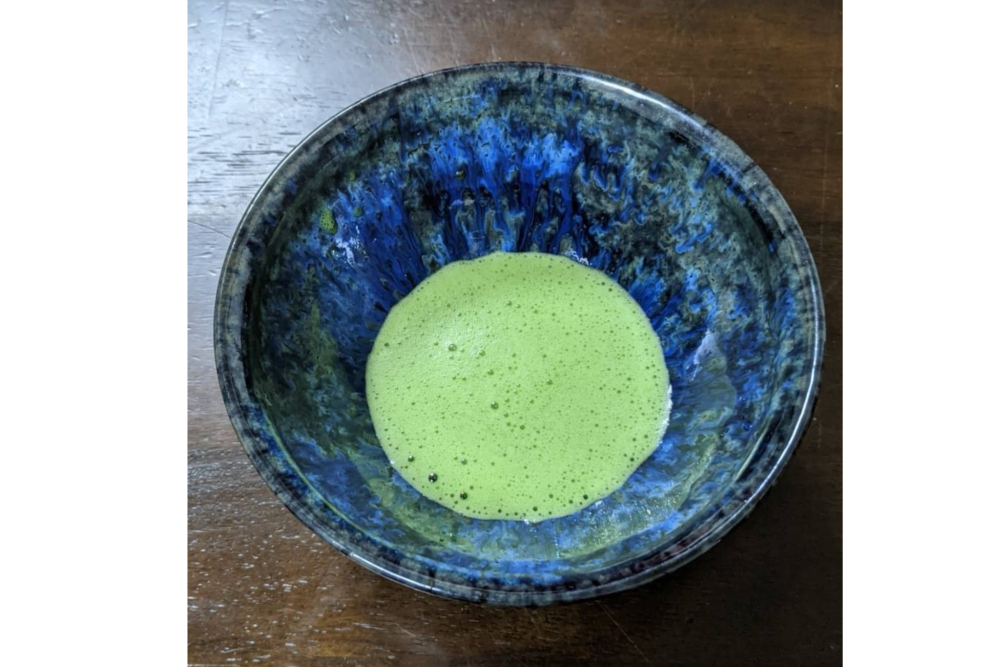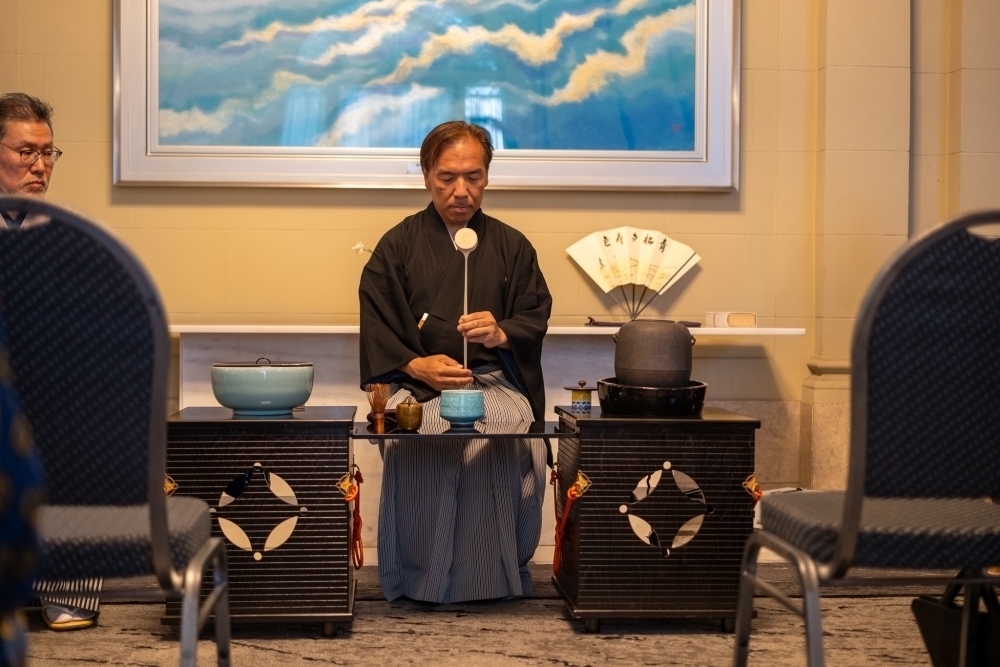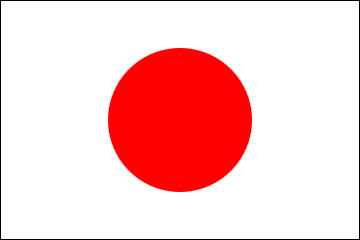From the Desk of Consul General Osumi
2025/1/23


Essay Vol. 17
~Welcoming Guests at the Residence 3: May I Offer you a Bowl of Tea?~
~Welcoming Guests at the Residence 3: May I Offer you a Bowl of Tea?~
January 23, 2025
Yo Osumi
Consul General of Japan in San Francisco
Yo Osumi
Consul General of Japan in San Francisco
Inviting guests to the Consul General's residence is a once-in-a-lifetime encounter. In Essay 11 in this series, I wrote about “Conversation topics, Setting, and Takeaways” as elements to making each visit a success. In Essay 13, I wrote about the “Food and Sake” served at each dinner. This time, I will write a few words about serving tea after the meal.
May I Offer you a Bowl of Tea?
As the guests finish Chef Igawa’s delicious desserts and the meals at our residence wind down, I invite guests to join me for a bowl of tea in the residence’s tearoom.
Whether due to Instagram or other factors, matcha has recently become very popular worldwide, and when it is put on sale in Japantown, it sells out immediately. However, this “matcha” is different from the matcha which the host diligently prepares in a traditional tea room for their guests. I have always believed that this practice should be translated not as “tea ceremony,” but as “the way of tea” -- it is not a simple ritual, but rather the crystallization of a spiritual culture of seeking. For convenience’s sake, though, I will use “tea ceremony” in this essay. We thus always start with an explanation for our guests: “The whole experience of drinking matcha here is very different from enjoying a ‘matcha latte’ in a coffee shop!” To study the way of tea is to deepen one’s insight into the culture of Japan, the culture that developed this practice.
How can we create a “Tea Room”?
When invited to a tea ceremony, guests walk through an open-air tea garden and path, rinse their mouths with water from the tsukubai (traditional stone basin), and enter the tearoom with a mind of purity (清, sei), one of the four main principles of the way of tea along with wa (和, “harmony”), kei (敬, “respect”) and jaku (寂, “tranquility”). The way of tea is a “once-in-a-lifetime" encounter with all those gathered that day, expressed in the Japanese phrase ichigo-ichie (一期一会). The tearoom is a place where the host and guests “create harmony together.”
Of course, in a Western-style building like the official residence, there is no open-air space. Therefore, when entering our tearoom, guests are asked to step through a screen partition so that they can feel the transition from the ordinary to the extraordinary, from the mundane to the sacred. The room is dimly lit, with a scroll displaying calligraphy of Zen teachings hanging from the wall and a single garden flower placed into a green bamboo vase. The subtle smell of burning incense fills the air, creating a world of jaku (寂, “tranquility”). The ideal of the way of tea is to pursue beauty in imperfection, far from geometric balance and overdone sound, and the tearoom is designed to allow guests to feel this spirit.
Once in a lifetime
In the very beginning of the Tale of the Heike, one of Japan’s great epics, it is written that “The bell of Gion Shrine echoes with the sound of impermanence in all things.” I am sure that at some point in our lives, we all come across the phrase “once in a lifetime.” Meeting in a tearoom, either as a master or as a guest, is an exercise in impermanence—truly a “once in a lifetime encounter,” a time and space that can never be duplicated.
It was probably the samurai who most keenly felt the cruelty of the concept of “once in a lifetime.” Sen no Rikyū (1522-1591), Japan’s preeminent tea master, developed the the way of tea at the end of the Sengoku (Japan’s “Warring States”) period. For warriors who spent their days in battle, tomorrow was not guaranteed. Samurai who practiced the way of tea would leave their swords on a rack in front of the tearoom before proceeding with their knees and necks bent to fit inside the tearoom’s low entryway. Even if two warriors shared a cup together that day, the next day they might have to face each other as enemies. The way of tea was developed at a time when that sense of impermanence in life was pervasive, which has greatly affected the way “once in a lifetime” became a phrase embodying the spirit of the the way of tea.
Ichiza Konryu
One of the things I have learned through the the way of tea is kei (敬, “respect”). The tearoom is not a place for casual individual tea drinking, isolated from the surrounding people, but a place for practicing ichiza konryū (一座建立), a phrase that translates to “the whole group creating harmony together.” It is in this collaborative spirit that guests and host are meant to care each other and form a sense of togetherness in the tearoom.
Therefore, when drinking tea as a guest, one should also show respect to fellow guests. Instead of grabbing the tea bowl and drinking, you place it between you and the person served prior and say, “After you,” or between you and the next person in line and say, “Before you,” to which the other person responds, “Please.” This is not something we usually do when we are served coffee, so when we ask our guests to do this, they seem a little embarrassed, but at the same time, it is a new experience for them, and they often end up chuckling as they engage in this practice.
After greeting both sides of the table, you place the bowl in front of you, bow with your hands pointed slightly toward the host, and say, “Thank you very much for the tea.” You then pick up the tea bowl and rotate it twice clockwise so as to avoid drinking from the front of the teacup offered by the host. However, this is just an expression of respect, and if someone with large hands turns the bowl twice, the front side of the bowl will return to its original position. Therefore, I say to them, “Two turns is just a guideline. It does not mean that you are forbidden to turn it once or three times. Do you think samurai cared about precisely how many times it must be turned? The spirit of the ceremony is to drink out of respect for the host, and to avoid the front, so turn twice-ish and don't let the front come back.”
The tea is served for as many times as the guest wishes, and the host is expected to continue to serve the tea without asking the guest to leave. The serving does not end until the guest tells the master, “Please let us finish,” at which point the host starts to wind up. To convey this to the guests, I often tell a little family story. One day, my wife, my eldest son, and I decided to have tea together. The tea that my eldest son made for us was delicious, and our conversation was lively. After the 15th serving, he looked at us and said, “My arms are tired. Give me a break.”
By the time the guests leave, the group is filled with the spirit of wa (和), or “harmony.”
I’m sure that my explanation of the finer points of the way of tea can get sprawling for our guests, but in closing, I like to share the words of Sen no Rikyū: “Remember this: The way of tea is just boiling water, preparing the tea, and drinking it.” If you taste and enjoy the tea, then that’s all there is to it. This is a characteristically Eastern philosophy: the idea that once you’ve mastered the format, you can appreciate the practice more freely.
Peacefulness through a Bowl of Tea
In “Tea Around the World: Half a Century of Internationalization of The Way of Tea” written by my teacher, Mori Somei, there is a photo of Hōunsai and Tantansai (the father and grandfather respectively of Zabōsai, the current 16th Grand Master of the Urasenke school) serving tea to Japanese Air Force pilots in flight suits at an outdoor ceremony near Kyoto in 1944. The 15th Grand Master Hōunsai was a member of a Kamikaze pilot squadron during the war, and many of his comrades went off for missions and never returned. He was said to have served tea to his comrades before they departed for those impossible missions.
Fort Mason, which can be seen from the Consul General's residence, was the departure point for many American soldiers who embarked for the Pacific front. The large army base in the Presidio below was the site where Prime Minister Shigeru Yoshida visited in 1951 and signed the Japan-U.S. Security Treaty on the same day as the signing of the San Francisco Peace Treaty (Essay 16). After the war, Hōunsai, who attended the peace treaty signing, traveled the world spreading the way of tea with his philosophy of “Peacefulness through a Bowl of Tea.” The Urasenke Tankōkai and the Urasenke Foundation, together with the Omotesenke Dōmonkai and others, have been working hard to this day, and I have often been invited to their activities.
Eighty years have passed since the end of the war, and Japan and the United States have become staunch allies. As a diplomat of our era, I always reflect on the fact that Japan and the Japan-U.S. relationship today owe much to the noble efforts of people like Grand Master Hōunsai. I share the story of Grand Master Hōunsai and the Kamikaze pilots while serving tea to my American guests because I feel that, just as between people, the relationships between nations and countries are multi-layered stories, best understood through sensitivity to the subtleties of both sides.
One of the things I have learned through the the way of tea is kei (敬, “respect”). The tearoom is not a place for casual individual tea drinking, isolated from the surrounding people, but a place for practicing ichiza konryū (一座建立), a phrase that translates to “the whole group creating harmony together.” It is in this collaborative spirit that guests and host are meant to care each other and form a sense of togetherness in the tearoom.
Therefore, when drinking tea as a guest, one should also show respect to fellow guests. Instead of grabbing the tea bowl and drinking, you place it between you and the person served prior and say, “After you,” or between you and the next person in line and say, “Before you,” to which the other person responds, “Please.” This is not something we usually do when we are served coffee, so when we ask our guests to do this, they seem a little embarrassed, but at the same time, it is a new experience for them, and they often end up chuckling as they engage in this practice.
After greeting both sides of the table, you place the bowl in front of you, bow with your hands pointed slightly toward the host, and say, “Thank you very much for the tea.” You then pick up the tea bowl and rotate it twice clockwise so as to avoid drinking from the front of the teacup offered by the host. However, this is just an expression of respect, and if someone with large hands turns the bowl twice, the front side of the bowl will return to its original position. Therefore, I say to them, “Two turns is just a guideline. It does not mean that you are forbidden to turn it once or three times. Do you think samurai cared about precisely how many times it must be turned? The spirit of the ceremony is to drink out of respect for the host, and to avoid the front, so turn twice-ish and don't let the front come back.”
The tea is served for as many times as the guest wishes, and the host is expected to continue to serve the tea without asking the guest to leave. The serving does not end until the guest tells the master, “Please let us finish,” at which point the host starts to wind up. To convey this to the guests, I often tell a little family story. One day, my wife, my eldest son, and I decided to have tea together. The tea that my eldest son made for us was delicious, and our conversation was lively. After the 15th serving, he looked at us and said, “My arms are tired. Give me a break.”
By the time the guests leave, the group is filled with the spirit of wa (和), or “harmony.”
I’m sure that my explanation of the finer points of the way of tea can get sprawling for our guests, but in closing, I like to share the words of Sen no Rikyū: “Remember this: The way of tea is just boiling water, preparing the tea, and drinking it.” If you taste and enjoy the tea, then that’s all there is to it. This is a characteristically Eastern philosophy: the idea that once you’ve mastered the format, you can appreciate the practice more freely.
Peacefulness through a Bowl of Tea
In “Tea Around the World: Half a Century of Internationalization of The Way of Tea” written by my teacher, Mori Somei, there is a photo of Hōunsai and Tantansai (the father and grandfather respectively of Zabōsai, the current 16th Grand Master of the Urasenke school) serving tea to Japanese Air Force pilots in flight suits at an outdoor ceremony near Kyoto in 1944. The 15th Grand Master Hōunsai was a member of a Kamikaze pilot squadron during the war, and many of his comrades went off for missions and never returned. He was said to have served tea to his comrades before they departed for those impossible missions.
Fort Mason, which can be seen from the Consul General's residence, was the departure point for many American soldiers who embarked for the Pacific front. The large army base in the Presidio below was the site where Prime Minister Shigeru Yoshida visited in 1951 and signed the Japan-U.S. Security Treaty on the same day as the signing of the San Francisco Peace Treaty (Essay 16). After the war, Hōunsai, who attended the peace treaty signing, traveled the world spreading the way of tea with his philosophy of “Peacefulness through a Bowl of Tea.” The Urasenke Tankōkai and the Urasenke Foundation, together with the Omotesenke Dōmonkai and others, have been working hard to this day, and I have often been invited to their activities.
Eighty years have passed since the end of the war, and Japan and the United States have become staunch allies. As a diplomat of our era, I always reflect on the fact that Japan and the Japan-U.S. relationship today owe much to the noble efforts of people like Grand Master Hōunsai. I share the story of Grand Master Hōunsai and the Kamikaze pilots while serving tea to my American guests because I feel that, just as between people, the relationships between nations and countries are multi-layered stories, best understood through sensitivity to the subtleties of both sides.
Recommended Information
- Essay Vol.1 (2023.11)
- Essay Vol.2 (2023.11)
- Essay Vol.3 (2023.12)
- Essay Vol.4 (2024.01)
- Essay Vol.5 (2024.02)
- Essay Vol.6 (2024.03)
- Essay Vol.7 (2024.04)
- Essay Vol.8 (2024.04)
- Essay Vol.9 (2024.05)
- Essay Vol.10 (2024.06)
- Essay Vol.11 (2024.07)
- Essay Vol.12 (2024.08)
- Essay Vol.13 (2024.09)
- Essay Vol.14 (2024.10)
- Essay Vol.15 (2024.10)
- Essay Vol.16 (2024.11-12)
- Essay Vol.18 (2025.02)
- Essay Vol.19 (2025.03)
- Essay Vol.20 (2025.04)
- Essay Vol.21 (2025.05)
- Essay Vol.22 (2025.06)
- Essay Vol.23 (2025.07)
- Essay Vol.24 (2025.08)
